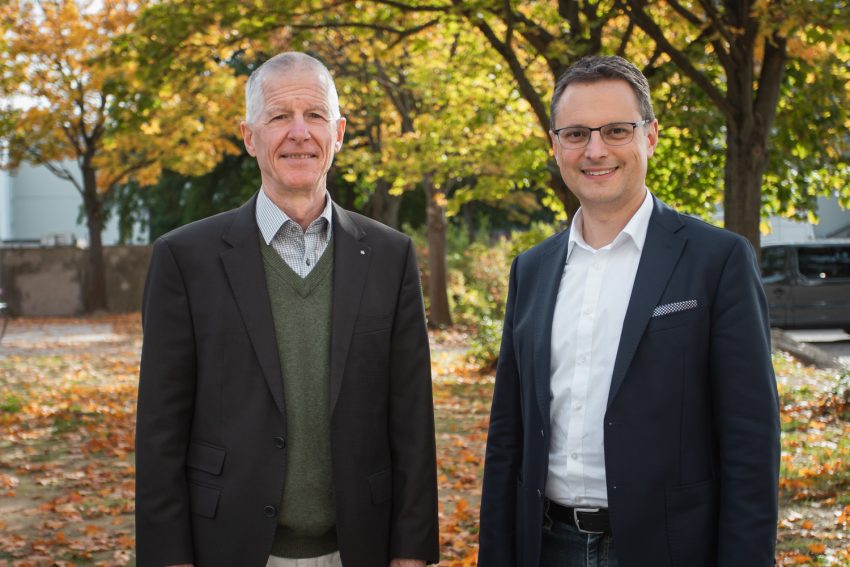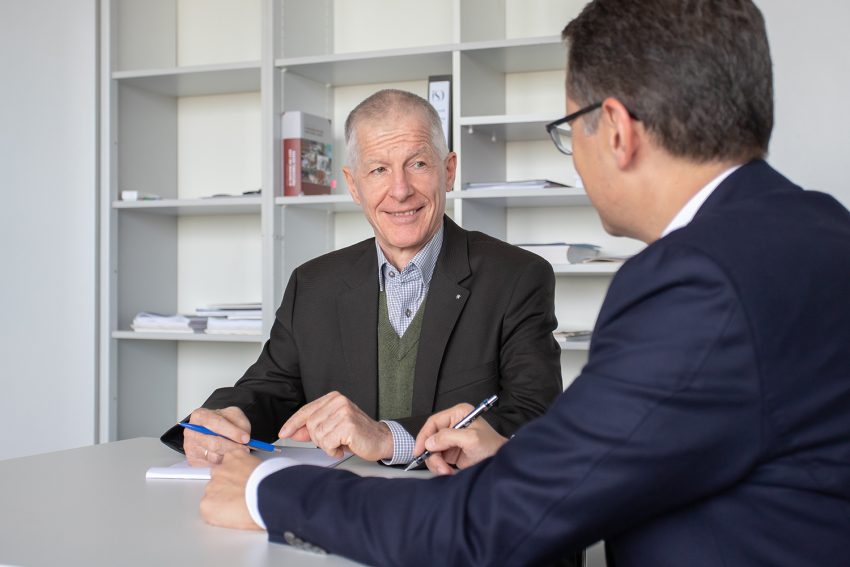Back at the Alma Mater Visiting Professor Rainald Löhner from the USA at the Institute of Structural Analysis
The Institute of Structural Analysis (ISD) is particularly pleased about this guest from the USA: 40 years after graduating from Technische Universität Braunschweig, professor Rainald Löhner from George Mason University in Fairfax is returning to his alma mater with a visiting professorship. Together, he and head of institute professor Roland Wüchner are planning a collaboration on simulation software and a long-term research cooperation on the challenges of our time, such as climate change, increasing extreme loads, natural hazards or the protection of structures and infrastructure.

Professor Roland Wüchner (r.) welcomes professor Rainer Löhner to the Institute of Structural Analysis. Photo credit: Max Fuhrmann/TU Braunschweig
The two professors have known each other for several years: through conferences, seminars, professional exchange and joint publications. This gave rise to the desire for a longer-term cooperation. “I am all the more pleased that we can now welcome Rainald Löhner as a visiting professor at the ISD and plan research projects together,” says professor Roland Wüchner.
Numerical simulation forms the bridge between the scientists. For example, both were involved in a practical transfer project that dealt with the investigation of large umbrellas in Mecca with an edge length of up to about 50 metres and wind excitation. “These constructions are absolutely unique and new ground was broken because the evaluation of the wind loads and the associated dynamic phenomena made the numerical simulation necessary for a design. Thus, simulation has made certain things possible in the implementation of structural engineering,” explains professor Roland Wüchner. Simulation is also the focus of the work of the research centre “International Centre for Numerical Methods in Engineering (CIMNE)” in Barcelona, of which both are members of the scientific advisory board. Here the scientists have met regularly and exchanged research ideas.
From Braunschweig via Wales to the USA
But of course Braunschweig also plays an important role in the cooperation. “The connection to the region has never been severed,” says professor Löhner. To this day, the native of Braunschweig, who incidentally is a great-nephew of the former rector Prof. Kurt Löhner (1964-66), has close family ties to the Lion City. “We are here almost every summer,” he reports. And he was also already well connected with the Institute of Statics, the predecessor of the ISD, and its former director professor Dieter Dinkler. Within the framework of graduate colleges, he held guest lectures here on the topic of fluid-structure interaction.
But what actually brought him to the USA? After studying Mechanical Engineering at TU, he did his doctorate at Swansea University in Wales with one of the pioneers of the finite element method (FEM), which is now the “main tool” of numerical simulation in research and engineering practice. He then received a call to the US Navy’s Naval Research Laboratory in Washington DC. Among other things, the mainframe computer that was there was an unbeatable argument for the job, according to Löhner. Today he heads the Center for Computational Fluid Dynamics at George Mason University in Fairfax near Washington DC. The main focus of his research is on the modelling and simulation of complex flow phenomena, for example to investigate the impact of wind or water on buildings and infrastructure, but also the spread of pollutants and aerosols. An important topic in connection with Covid-19: “Here we analyse how we can change air conditioning systems to prevent the spread of such aerosols.”
Next visit in spring

“The connection to the region has never been severed,” says professor Löhner. Photo credit: Max Fuhrmann/TU Braunschweig
Löhner is also researching pedestrian flow simulations. A joint project is now being developed for this, which deals with person-structure interaction, i.e. the interaction of walking people and supporting structures. The coupling of the simulation software of the two working groups was already successful during his first stay at TU Braunschweig. For long-term cooperation, they are focusing on the challenges of our time, such as extreme weather events with changed wind and weather loads due to climate change, but also, for example, the problem of high population density in megacities and forecasts for ageing building structures.
The next longer visit by the visiting professor is planned for spring 2023. After he has visited some experimental facilities over the past two weeks – for example, the wave channels in the Leichtweiß-Institute for Hydraulic Engineering and Water Resources – and met scientists from the faculty, meetings with other interested researchers are on the agenda for next year. Then professor Löhner and professor Wüchner also want to generate ideas for joint research proposals.
